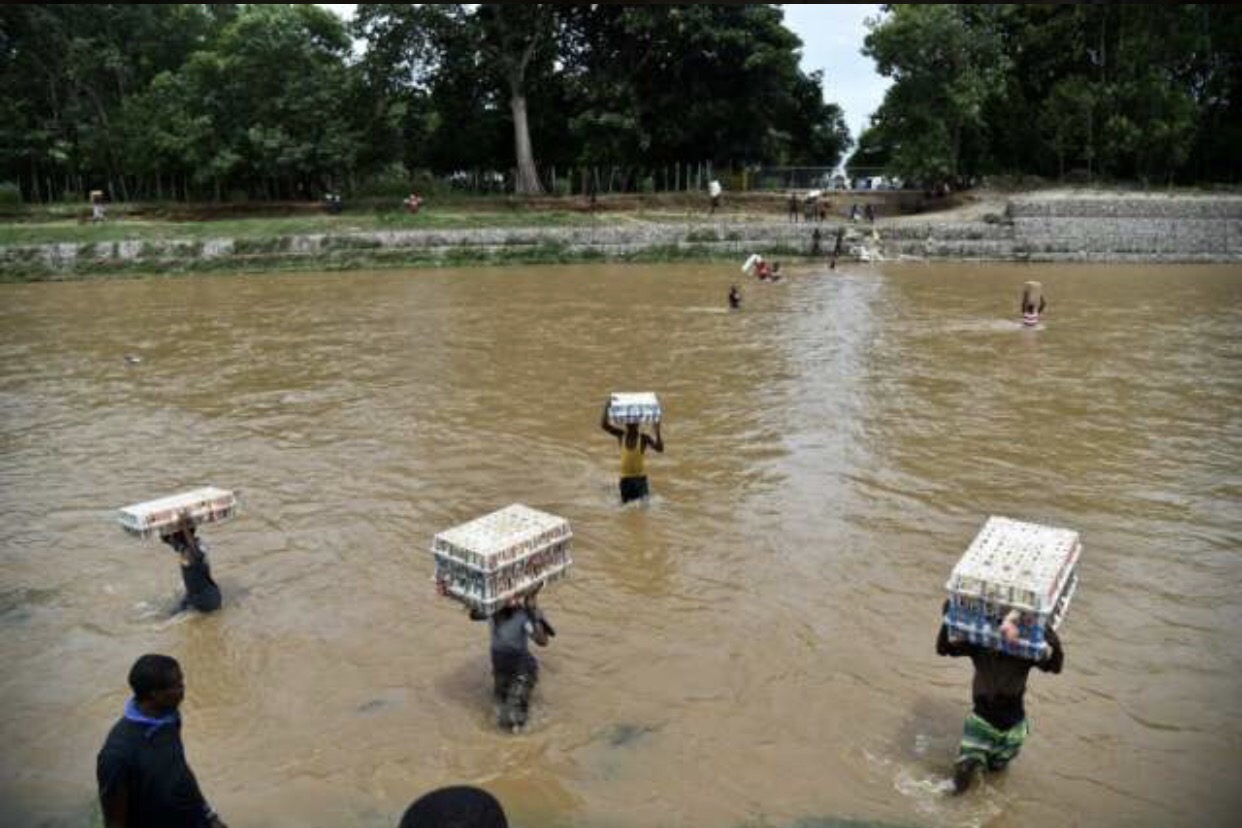Port-au-Prince—My friends in Haiti told me not to come—too much chaos, too much violence. if i insisted on coming, they advised, I had to find a bodyguard, a driver, and an armored car. They said: Bring expired credit cards to give to armed robbers; don’t bring cash. Dress down (as if I ever dress any other way) and don’t wear jewelry. And of course, don’t visit any ATMs or banks. Don’t go near the shantytowns, where I previously spent hours talking to people, hanging out. Don’t drive late at night. Don’t go downtown.
It all seemed a little extreme. But then, a week and a half before I arrived, a French couple who had never been to Haiti before were killed shortly after they flew in to adopt a kid—gunned down in front of their hotel, in an area you pass all the time, no matter where you’re going.
For more than a year, the country has been rocked by protests against its corrupt president, Jovenel Moïse, a former banana dealer known in Haiti as Neg Banann, and against the corrupt political system more broadly. Peaceful sit-ins came together outside government buildings in the capital, and large, stirring marches took place throughout the country. The system responded: Well-armed police in battle gear fired on many of the protests, and at least 187 people were killed, some execution style. Journalists were assassinated.
By the time I was planning my trip, Haiti seemed on the edge of a crisis or breakdown. I’d seen such moments there before. Sometimes they would swing in favor of the people, more often in favor of the ruling elites and the status quo.
Haiti was cornered—exhausted, hungry, exasperated with the old, afraid of the new. To make matters worse, in mid-January, the 10th anniversary of the earthquake that killed more than 100,000 people would arrive, and so would the international media, to show Haitians and the rest of the world how little the country has changed for the better during the past decade, how deeply it has sunk back into the old, bad ways. Yet new threads of hope were gleaming and glittering through this dark material, new ideas coming from young people who feel that without change, they have no future in this country. Older opposition figures—some valuable, some not—are also trying to figure things out, a fractious but united group whose breadth hasn’t been seen here recently.
By the time I was planning my trip, Haiti seemed on the edge of a crisis or breakdown. I’d seen such moments there before. Sometimes they would swing in favor of the people, more often in favor of the ruling elites and the status quo.
Haiti was cornered—exhausted, hungry, exasperated with the old, afraid of the new. To make matters worse, in mid-January, the 10th anniversary of the earthquake that killed more than 100,000 people would arrive, and so would the international media, to show Haitians and the rest of the world how little the country has changed for the better during the past decade, how deeply it has sunk back into the old, bad ways. Yet new threads of hope were gleaming and glittering through this dark material, new ideas coming from young people who feel that without change, they have no future in this country. Older opposition figures—some valuable, some not—are also trying to figure things out, a fractious but united group whose breadth hasn’t been seen here recently.
Meanwhile, Haitians continue to face what Pierre Esperance, executive director of the Haitian National Human Rights Defense Network (RNDDH), has called “the ongoing gangsterization of the state.” Armed gangs—estimated to number in the dozens—regularly receive funding, automatic weapons, and ammunition, although as Esperance points out, Haiti doesn’t make weapons or ammo, and the country has been under an on-and-off arms embargo for many years. These gangs have carried out five massacres during the Moïse administration, the worst of them in a shantytown known as La Saline, a hotbed of anti-government protest that borders one of Port-au-Prince’s best-known open-air markets; at least 71 people were brutally murdered there.
All the protests have posed a question central to national sovereignty: Who owns the nation—the people or the government and business class? “Kot kob PetwoKaribe?” (Where’s the PetroCaribe money?) has been the protesters’ cry, a reference to the late Venezuelan president Hugo Chávez’s aid program for Haiti, whose funds have been ruthlessly plundered by government officials and their friends. The plunderers include Moïse, according to a damning 656-page report by the Haitian government’s own auditors. The PetroCaribe funds were meant to develop housing, sanitation, roads, health care—things that Haitians need desperately. But most of the money is gone, vanished into political pockets and, through various kinds of nepotistic zombie contracts, into the wallets of good friends of the current administration and its predecessor.
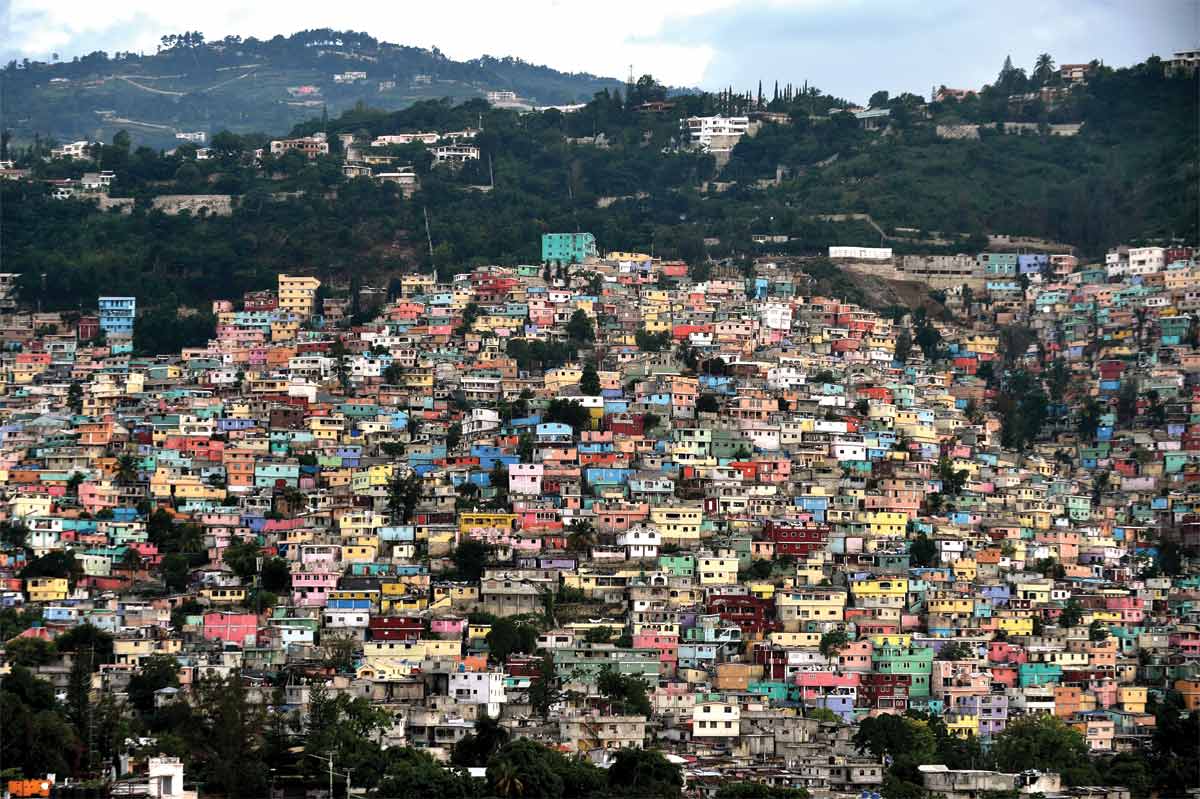
(Hector Retamal / AFP via Getty Images)
More damningly, in February 2019 supporters of Moïse (and possibly the president himself) sent a band of US mercenaries to protect an official who went to the central bank downtown to transfer $80 million from the PetroCaribe fund to an account controlled exclusively by the president.
For three months this fall, the opposition put the country on repeated lockdowns. No one violated peyilok, as it is called. People starved but didn’t (or couldn’t) go out to buy food; people were sick but couldn’t get to the doctor. You couldn’t work. By the time I arrived in December, kids hadn’t been able to go to school since the term began in September. The dead couldn’t be taken to the morgue. During these days and weeks of peyilok, the opposition called on various sectors of society to march in protest—labor, clergy, artists and musicians, medical workers, students, and others. But meanwhile, armed gangs of no clear provenance roved the streets, shooting at will.
Still, Moïse says he is committed to serving his full term, which ends in 2022. Late last month he moved from virtual silence into neo-Duvalierist mode, saying there were a number of people whose heads he intends to “cut off.” He threatened that there will be “accidents” if people get in his way. Silent regarding the massive opposition against him, Moïse focused his rage on an energy provider that sells electricity to the state-run Electricité d’Haiti, another trough of possible corruption that he has long desired to control.
“What happens when the unstoppable force meets the immovable object?” asked Kim Ives, a veteran Haiti observer, referring to the protests and the president. “In Haiti, the answer seems to be: You form a commission.”
There are now several commissions militating for Moïse’s orderly departure, the resignation of the useless Parliament, and the installation of a replacement government in some form. They range ideologically from fairly far left to pretty far right. What is unprecedented is that they’ve been trying to work together. Still, for the young, who make up the majority of the country’s population and have been crucial to the protests, the results have been less than spectacular.
“We are against corruption and impunity, and we are for social justice,” said Pascale Solages, a young leader of the group Nou Pap Dòmi (We Will Not Sleep). NPD is part of the enormous Petrochallenger opposition, which mostly consists of young people who have come out repeatedly to protest the government’s impunity over its plunder of the PetroCaribe funds. Solages and I sat at a long table at a restaurant NPD often uses as a headquarters. Surveying the various groups clamoring for Moïse’s ouster, Solages added, “I don’t have a single view of the opposition. But for the most part, it is run by a political class that the population does not trust. For the last 30 years they’ve been destroying Haitian institutions, which are now on their knees. We need a new political class and a profound change.”
After months of peyilok—and amid concerns about further instability in this “shithole” country—the Trump administration, previously indifferent to Haitian affairs, sent down three US officials in turn for brief visits and photo ops with Moïse. The meetings changed the tenor of the national conversation. Each American bureaucrat advised the Haitian president to meet with the opposition, but none suggested that he depart. Then they left. It was clear the US government was not going to whisk Moïse away; he was its obedient friend. At the United States’ behest a year earlier, Haiti’s ambassador to the Organization of American States (OAS) voted against recognizing the legitimacy of Nicolas Maduro’s election in Venezuela. Maduro is the successor of Chávez, who had provided all the PetroCaribe money for Haiti.
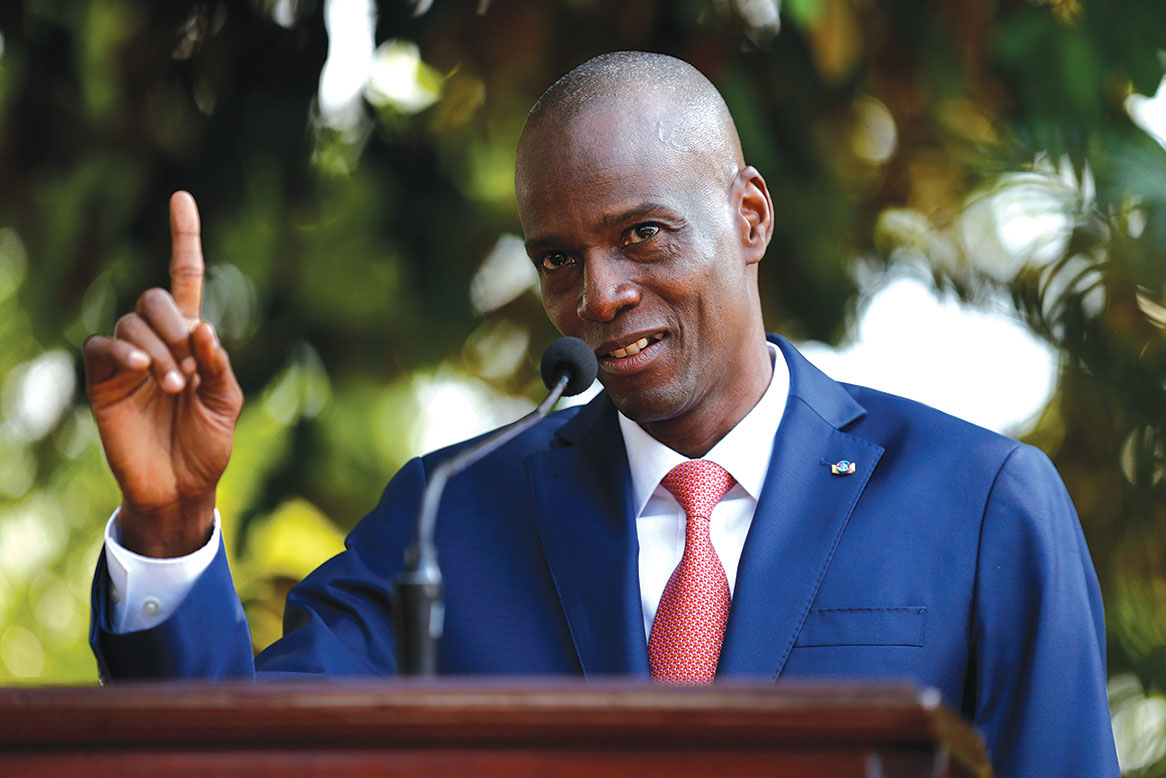
Not going: Haitian President Jovenel Moïse has defied repeated calls to resign—warning that there will be “accidents” if people get in his way. (Rebecca Blackwell / AP)
After the visits, Moïse reached out to the opposition, as recommended by his American friends, always with the understanding that he was not going to leave. The opposition initially refused his invitation. That’s when I arrived, expecting peyilok, armed gangs, paralysis. I took an armored car to my hotel with two big bodyguards in the front seat. In spite of all the dire warnings, everything was calm. Feeling ridiculous—even foolish—and extremely white, I quickly abandoned the security detail. From then on, my stay was in many ways like every other time I’ve spent in Haiti. Although we drove high up into the hills above town and then far downtown into the poorest and most crowded areas and then over to the shantytown where I’d been told I absolutely could not go, we had no problem.
What accounted for this relative peace? It was the opposition unlocking the country. Haitians were growing restive and resentful under the strictures of peyilok. “People are tired of it,” Solages said. Also, the opposition did not want to seem unaware of the US position; they needed a space from which to negotiate that didn’t appear intransigent.
Interestingly, Haiti has now gone from peyilok, which exerted real pressure for a change of government, to a political paralysis from which it’s hard to see an escape route. Moïse’s position remains precarious. On one side, he faces an angry, organized, and militant population trying to push him out. On the other, his friends need him to remain in power so the plunder can continue. Moïse is no doubt worried about both the people and his friends. In French they call his position coincé, or cornered.
In the midst of all this, no one but the current president believes in the value of future elections. Elections brought Haitians the corrupt Moïse—even though it took 14 months from the initial ballot to the final result, with all sorts of shenanigans in the process. An earlier, questionable election, the results fudged with the connivance of OAS personnel, brought them the corrupt Michel Martelly, whose sole qualification for the presidency was his fame as a singer and entertainer.
Most Haitians simply don’t believe in elections as they are currently run. To quote the former president Jean-Bertrand Aristide, who was elected in a 1990 landslide that no one has yet questioned (or duplicated), elections in Haiti have since turned into “selections.” Aristide, by the way, was ousted in a coup green-lit by George H.W. Bush’s administration just nine months after that landslide. So much for the legitimately elected.
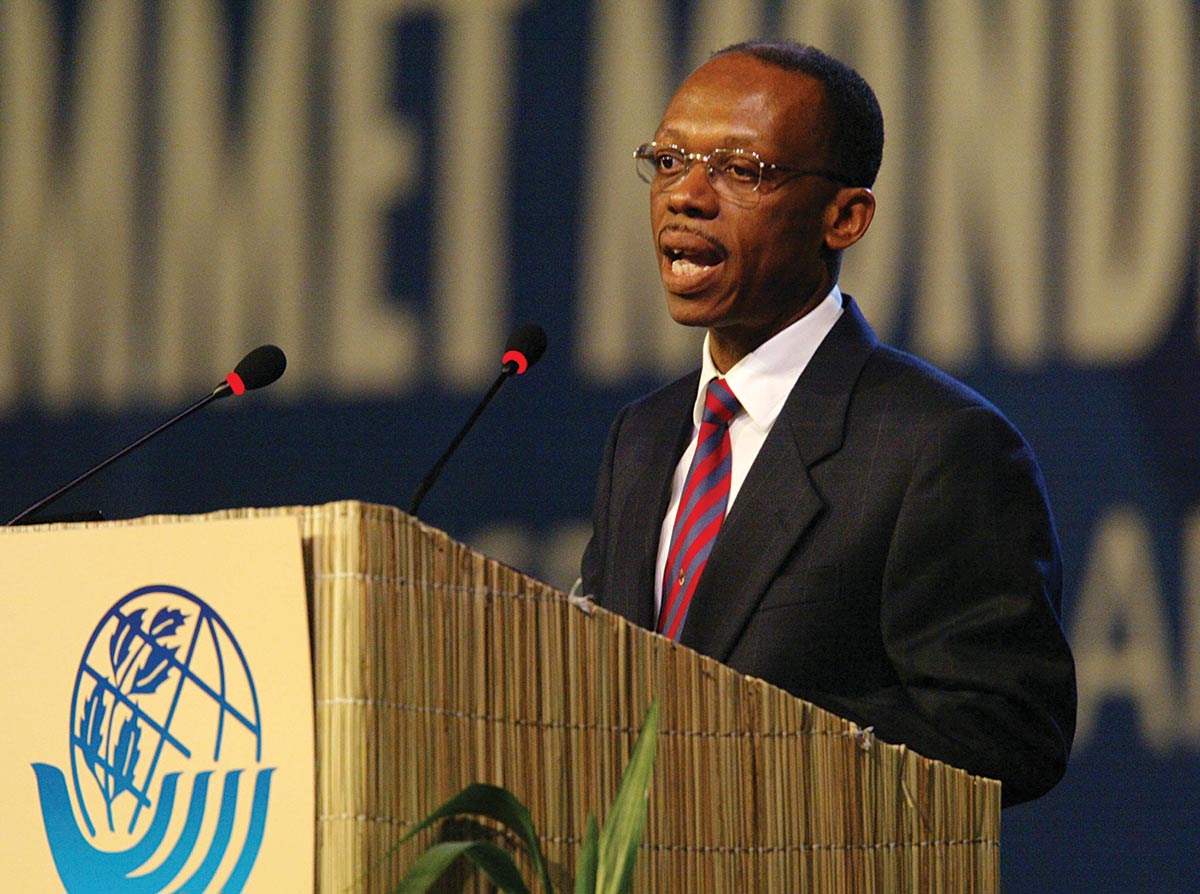
Yesterday’s man? Jean-Bertrand Aristide was elected president in a 1990 landslide that none of his successors have matched—which didn’t protect him from a US-sponsored coup. (Anna Zieminski / AFP via Getty Images)
Today Aristide lives in a large white house in Tabarre, a suburb of the capital that was farmland when he built his home there some 30 years ago but is now part of the growing Port-au-Prince metropolitan area. There are peacocks and peahens roaming his front lawn.
Aristide seems to have retired from political life after the presidential candidate he backed lost the contested election that Moïse eventually won. But in Haiti, tou sa w we, se pa sa, as the expression goes: All that you see is not what it seems. And many think Aristide is still working behind the scenes.
He greets me in his very presidential office: huge desk in the center, white walls, white tile floors, bookshelves, the Haitian flag. He is wearing a formal white guayabera and pressed pants and doesn’t seem substantially changed from the person I first met back in 1986, when Jean-Claude Duvalier (aka Baby Doc, the son of François “Papa Doc” Duvalier, the country’s notorious longtime strongman) had just fallen. Back then, Aristide was a firebrand priest from the poorest parish in town. His break with the church, his two presidencies (or three, depending on how you count them), the two coups d’état against him, his two forced exiles, marriage, fatherhood, projects of all kinds—nothing seems to have changed him. He remains the kind of person who would love a peyilok movement. No doubt he’d like to lead it.
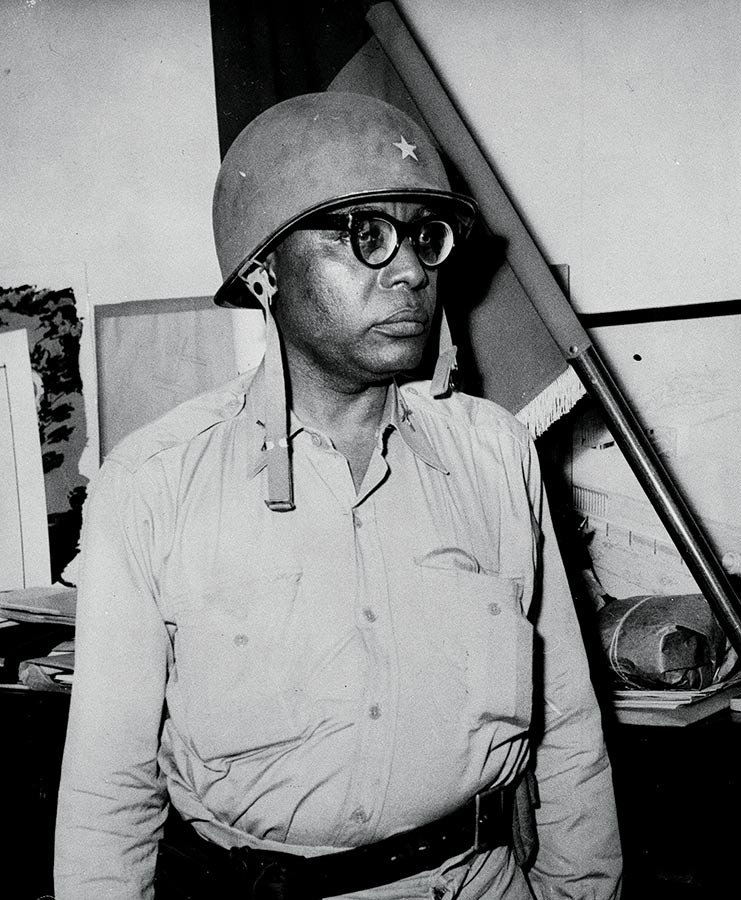
Papa Doc at war: President for Life François Duvalier fighting off a military coup in 1958. He led his despotic regime for 13 more years, until his death. (AP)
Aristide’s radicalism in the mid-1980s, which grew out of liberation theology, seemed unacceptable to the moderates then running the world. It might be more acceptable now, especially since it has been embraced by the new generation, both in Haiti and elsewhere. In 2003, long before Ta-Nehisi Coates’s famous piece in The Atlantic, Aristide presented France with a $21 billion bill for the 90 million gold francs in reparations that Haiti (the victor, remember) was forced to cough up to France (the loser) after the Haitian Revolution in 1804. (France cavalierly rejected Aristide’s payback demand and promptly collaborated with the United States to remove him from the presidency—for the second time.) Still, in spite of Aristide’s historic feats, it seems unlikely that a person with his vexed history, in Haiti and the hemisphere, can carry the banner for a new way forward.
But Aristide is not the only name from the past that gets mentioned in discussions of Haiti’s future. As a toddler, Nicolas Duvalier fled the country with his family when his father, Baby Doc, was overthrown by a popular uprising in 1986. Though Nicolas Duvalier grew up mostly in France, he’s been toying recently with a future in Haitian politics. “We are not there yet,” he said when asked if he’ll run for president. But there’s a saying in Haitian Creole (there’s one for every occasion): Ptit tig, se tig. The son of a tiger is a tiger.
Haitians are thinking about the earthquake as its anniversary approaches. They’re always thinking about the earthquake, actually, because everyone lost someone in it and because the rebuilding effort has been such a massive disappointment. Most of the money promised to Haiti for reconstruction has been squandered or stolen or lost—or was never delivered in the first place. Bill Clinton’s Build Back Better campaign for post-earthquake Haiti has been a total failure, despite the campaign’s declaration amid the rubble that the country was “ready for business.”
Clinton was appointed the United Nations special envoy for Haiti eight months before the quake struck. (He and Hillary Clinton spent part of their honeymoon there in 1975.) Much of the funding that came in after the earthquake went to US contractors for projects, fees, housing, food, and security. Less than a penny on every dollar ended up with Haitian groups.
A few banks downtown have been rebuilt, but there is still earthquake rubble in the area behind them, topped with burning garbage, through which the poorest of the poor are scavenging. Even on Grande Rue downtown, once the city’s business center, you can see 19th century buildings ready to collapse. People live and work precariously amid the rubble or are constructing concrete buildings that don’t abide by any seismic code. A few shantytowns were created during reconstruction, but they are now overrun with gangs and drugs.
There are some new hotels, most functioning at a reduced level because of peyilok and because the post-quake international relief caravan has moved on to more fruitful fields. Interestingly, the most lucrative clients the hotels have attracted recently have been the opposition factions that met to produce what are known as the Marriott Accord, which seeks the replacement of the entire Moïse government, and the Kinam Agreement (at the Hotel Kinam), which calls for the replacement of the entire government—except for Moïse.
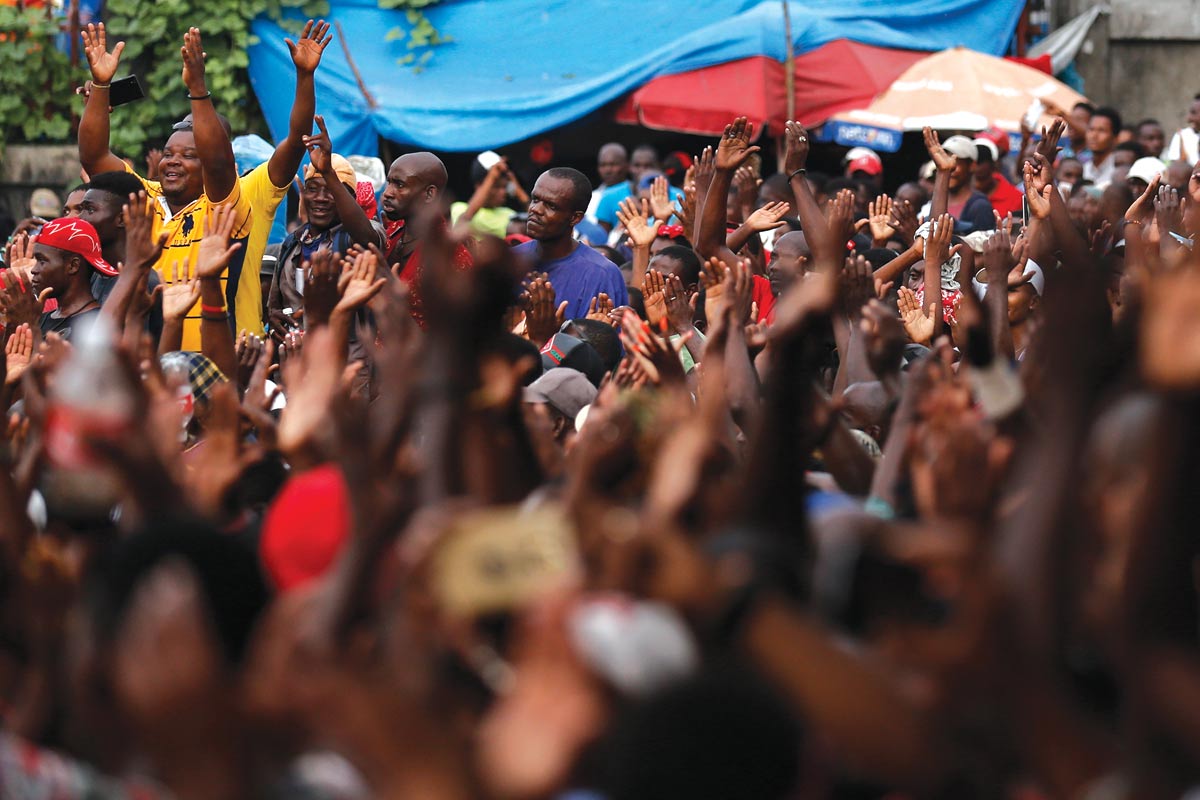
A country in lockdown: During the months of peyilok, different sectors of society each marched. Here, artists from Port-au-Prince take to the streets. (Rebecca Blackwell / AP)
“Haiti is a little machine that produces gigantic amounts of corruption,” said Frantz Duval, the editor of Le Nouvelliste, the French-language daily in Port-au-Prince. “The earthquake was like PetroCaribe. All that money suddenly turning up was an opportunity for thievery. And there’s kind of an entente cordiale among the thieves splitting up the booty. There was a period of enjoyment after the earthquake when everyone was in the game—just like PetroCaribe.”
This is why Petrochallengers like Solages don’t just want to displace Moïse; they want to get rid of the whole damn system. Most people here don’t go into government for the love of statecraft or out of a desire to serve the public. They do it to enrich themselves as much and as quickly as possible before they’re ousted by the next batch of thieves. Periodic elections do little to intrude on this musical-chairs mechanism; they simply offer an illusory authenticity to each successive wake of vultures.
By the middle of December 2019, the opposition began to send out feelers to Moïse. The message that the United States wanted him to stay had been received. This doesn’t always play out, though. At the end of January 1986, President for Life Jean-Claude Duvalier stood before the Haitian people and told them, “I am here, stronger than a monkey’s tail.” A week later, he was on a US C-141 transport plane bound for Paris.
It turned out the Reagan administration had other ideas about who could run Haiti. The State Department put together a claque of Haitian political figures and army officers known officially as the National Council of Government but called by Haitians what it was: the junta. The Trump administration, au contraire, apparently can’t imagine an alternative to its pliant Haitian banana dealer.
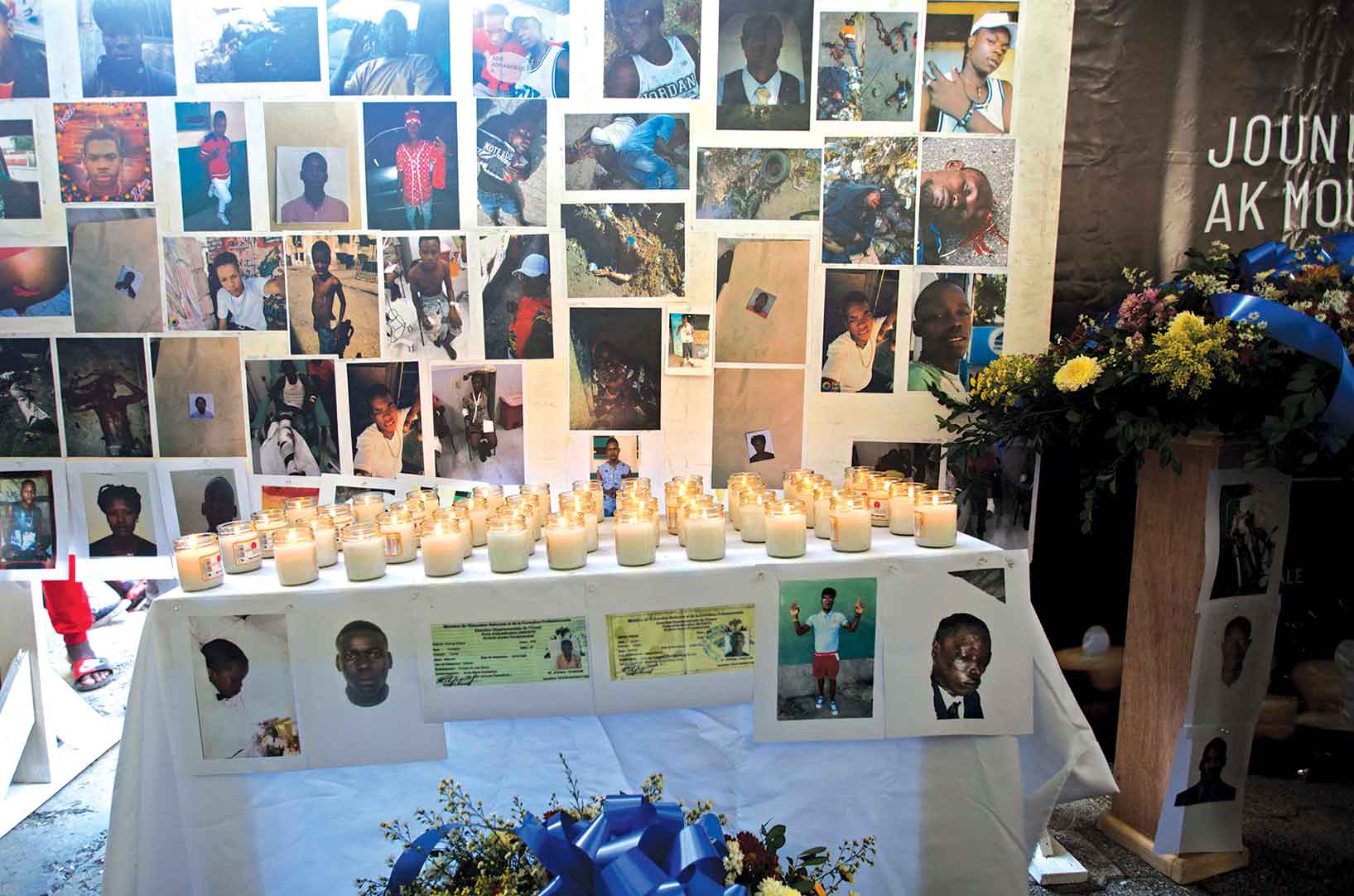
Not forgotten: An altar commemorating the victims of La Saline massacre. (Dieu Nalio Chery / AP)
Idrive to an end-of-the-year picnic in the mountains above Port-au-Prince in a convoy with a group of businesspeople, diplomats, and their families. On the way up, the city falls away, and then you’re in the Haitian countryside. The hills are steep, and terraced emerald farms climb the sides of the canyon. Strong, thin farmers—kiltivatè, as they’re called—walk by the side of the road carrying their machetes. Women walk there too, carrying produce to market in baskets or black garbage bags, a more modern accessory, on their heads. Roadside shacks and little stalls sell fruit and water in the smallest to-go plastic bags.
At the picnic, a beautiful little blond girl is swinging from a hammock and talking about her grandparents’ house in Palm Beach—“not on the beach, though.” But where do you live? “In Haiti, of course, but we’re moving.” Where to? “I don’t know. Bahamas, Croatia….”
“We are all moving out of the country,” says one glamorous matron from an old and wealthy family. “We’re all selling our houses. Except, of course, no one is buying. Because the people who could buy are all selling, obviously. The situation in the country is unacceptable. We can’t sit through another one of these episodes. We have to go. And the thing is, what these people don’t understand is, we are the state.”
The implication is clear: When they go, Haiti fails. Though from what I’ve been told, the elite moved most of their money out of the country a long time ago.
Richard Widmaier runs Radio Metropole, which in one form or another has been in his family for four generations. He’s not a big enthusiast of Moïse (“He has a passion for two things: agriculture and himself”) but still thinks he should remain in office. “OK, he really should have just been minister of agriculture, which maybe he could have handled,” Widmaier says. “But a president who’s elected for five years should serve for five years.” It’s a point of view held mostly by people with connections to the present government—or who understandably fear the chaos that might ensue if Moïse steps down.
Later that day, I’m with a businessman up in Pétion-Ville, which used to be a safe haven from the craziness of downtown until the earthquake came and downtown moved uptown. We’ re having a lovely dinner on a covered terrace, palm fronds shaking in the breeze, pretty little sconces and chandeliers over the tables. My friend is eating the biggest crab I have ever seen. We’re chatting in a preliminary way when he gets a call.
“Another kidnapping,” he says as he takes the phone out of the restaurant. “I can fix this,” I hear him say to the person on the other end. Four minutes later, he comes back to the table, and we finish our meal almost as if nothing out of the ordinary had happened. Two days later, the victim is released. A ransom was paid. Kidnapping is a business in Haiti now.
Ihave an old friend in Haiti who has worked in difficult political situations there for pretty much her whole life. She has moved up and down through nongovernmental organizations, and she’s Haitian, so she understands the lay of the land—and doesn’t want me to use her name. After Duvalier fell, she says, Haitian civil society burst into activity. There were all sorts of meetings—tet ansanm (heads together) is the term in Creole—of intellectuals, artists, professionals thinking about ways to jump-start the country. “And the thing is, they were all doing it on their own,” she says, “without start-up funds or not-for-profit status or money from foreign groups.” Farmers were still managing to grow and survive on their small plots of land. Back then, Haiti still had food self-sufficiency.
Now, she points out, Haiti is the second-largest importer of US rice, after Mexico. I hear this fact mentioned everywhere I go, because it is astonishing to Haitians. The country’s fertile Artibonite Valley once provided more than enough rice to feed Haiti. The story of how rice production failed is long, but it includes subsidized US rice being dumped on the Haitian market during the Clinton administration, with much of the grain coming from Arkansas farms. As cheap US rice undersold locally produced rice, farms in Haiti collapsed, and people from the countryside moved to the capital, where they eventually lived in shacks and shanties and ended up eating US rice. When Duvalier left, my friend continues, the Haitian poor were still fit and healthy. Now they eat “really scary” imported stuff, and illnesses that used to be rare—like heart disease, diabetes, and cancer—are increasingly common.
She paints a picture of the pastoral Haiti that I remember. There were ideas and activism and a lot of energy. Living was cheap. Professionals could reside in leafy neighborhoods, and even though they earned only $600 or $800 a month, rent was just $50. But in 1991, when the first UN observers arrived (after the initial coup against Aristide), some were earning $6,000 a month, and rents rose.
“Every natural disaster here brought with it new outsiders,” my friend says. “The value of things is no longer measured by the national but by the international market. Haitians are priced out of everything, including food. To put together a group, you have to rely on outsiders to fund you, and your innate Haitianness gets lost or muddled.”

Book by book: In Cité Soleil, where armed gangs roam the streets, a library is being built by the community. (Hector Retamal / AFP via Getty Images)
“Haitians aren’t the same as they were in 1986,” says Marcus Garcia, a longtime editor and radio host. “There’s not much hope. And the politicians are not the same. There are no éminences grises. All the communists are dead. The intellectuals are dead. The objective press is finished. The diaspora is desperate and disappointed. There’s just a big void everywhere.”
What is new and good in the country, he adds, are the young. For a while, after the earthquake, they fled; there were two planes a day to Chile and Brazil. “With the changes in those countries’ governments, that’s no longer an option,” Garcia says, “and so the kids have nowhere to go. They have to fight for their lives here, and that’s what we’re seeing.”
My old Haitian friend from the NGO world agrees that there is healthy protest right now, and she’s cheered by this. But she also has ideas for Haiti’s long-term future. Like many, she believes that it would be healthier for Haiti to avoid the global economy than to participate in it. There is a nostalgia for decent poverty these days, for what Aristide called sitting at the table, not under it.
This same idea was proposed by the Haitian geographer Georges Anglade in his 1983 book Elegy for Poverty. Anglade—who died in the earthquake—argued for the brilliance and know-how of the Haitian peasantry against a global economy that, at best, provides assembly jobs for the poor and the loss of all tradition. Nearly 40 years after the book’s publication, his Haiti has been almost eradicated.
In Haiti there was once something called the konbit, a cooperative handed down from the early days of the colony, when the enslaved population was responsible for any improvement in their lives. Roof raising was a particular activity of the konbit, and the tradition continued long after the revolution. During a konbit, the community would assemble. Food was cooked, songs were sung, stories were told, and children frolicked; meanwhile, a roof was raised for a neighbor. Or a path to a field was built. Or a community garden was planted. The konbit would be repaid with later good deeds for other members of the group.
What my friend is mourning and what Anglade worried about decades earlier is the loss of such communal effort and competence as cash—in the form of international aid—enters the economy. After the earthquake, for example, people didn’t form groups to protect women in the camps from rape. Instead, victims went from one foreign relief organization to another, seeking funds and rape kits. This didn’t protect them from more attacks, but it did bring in cash, and the aid organizations could add another rape to their fundraising lists. The konbit builds solidarity on the ground that can be sustained, unlike a cash influx.
In the old days, a big konbit could have gotten rid of the earthquake rubble near the port downtown within a month and without pay, because it had to be done. Today, with no one paying and the big yellow trucks from the international relief organizations gone, the rubble remains. When your country is no longer your own, you wait for others to fix it for you or pay you to fix it. Pride of ownership has faded in Haiti, which used to be one of the country’s signal characteristics, since it was precisely ownership of themselves—their bodies and their land—for which Haitians fought a revolution.
There is a realism in Haiti-pessimism, but Haitians’ struggle for the soul of their country is not yet entirely lost. In Cité Soleil, one of the most battered shantytowns, where armed gangs roam and people live near a much-photographed river of sewage, there is a library being constructed opposite the police station where shantytown residents can go to borrow books; study for tests; learn to use computers; record in the recording studio; work in the language lab on their Creole, French, Spanish, English, or Arabic; rent a room as an office or workspace; or just hang out at the cafeteria or play in the playground, and it’s being built mostly with small contributions from the community and from visitors. (Everything described above is still en train but visibly underway.) It’s a form of konbit.
Downtown there is the Ghetto Biennale on Grand Rue, where foreign artists come and meet Haitian artists and work for a week. (Despite the current unrest, more than 30 foreign artists turned up for this great tradition, which begins in mid-December.) There’s the annual jazz festival, during which musicians play all over town. There’s Grande Plaine, the tiny peasant community outside the town of Gros Morne that has reforested its area with the help of family members living abroad. There’s the park in Martissant that neighbors—including gang members—cultivate and use for recreation and craft markets. Little shoots of possibility everywhere.
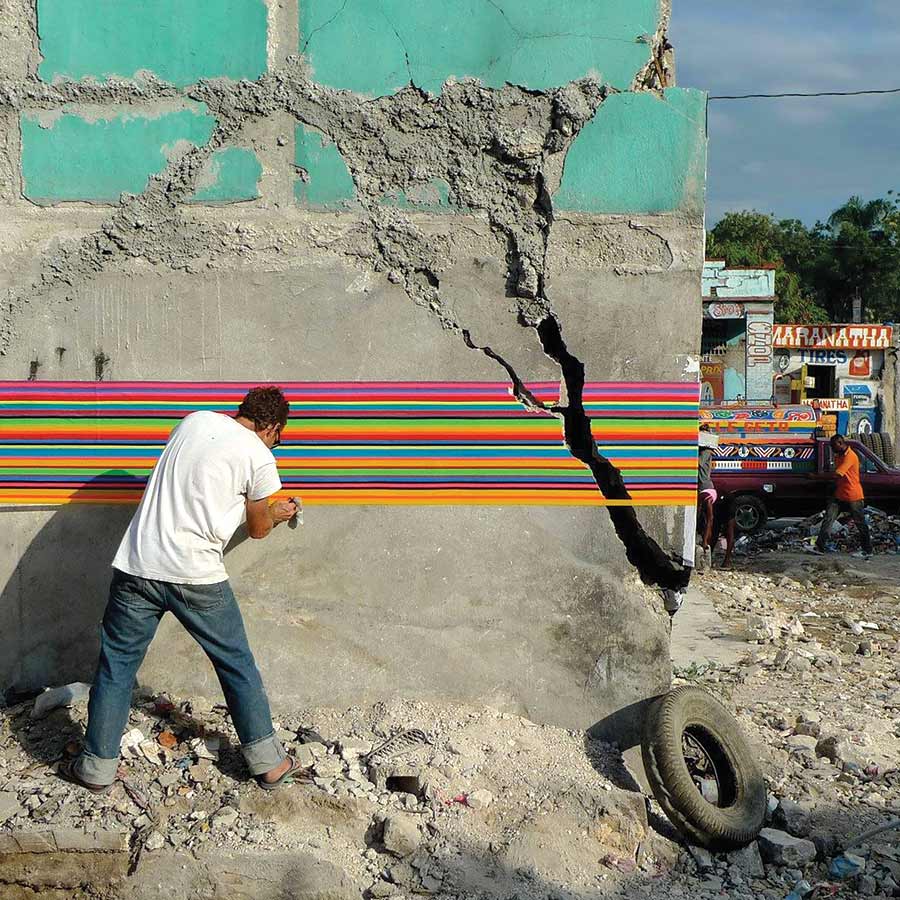
The Ghetto Biennale: This December, more than 30 foreign artists arrived for a week of work and conversation with their Haitian counterparts. (Fungus Collective)
Later, I’m driving up a hill to get away from downtown and look at art, but really I’m already in a Haitian tableau. Sky blue. Puff of bright white cloud. Strange wisps of smoke along the roadside: garbage burning, corn grilling. Small businesses dot the landscape, everything terraced, shacks topped with corrugated tin and stairways leading to nowhere (a Haitian architectural specialty). Rebar sprouts in bunches from concrete like some strange heliotropic plant, awaiting further building instructions that may or may not come. Small cardboard churches with colored cellophane windows hang from trees. These are the annual fanales, for sale as Christmas decorations, because everyone is hoping things will stay quiet and Haiti will have its beloved Christmas this hard year. Beyond the road hides the countryside as we limp up the hill.
Finally we arrive.
And now I’m having lunch with a member of the country’s 1 percent, in a rambling stone house that once belonged to a Haitian president. We (a Swiss artist-intern, a young Haitian assistant, and me) sit down at the table. We’re waiting for the master of the house; the rest of his family has left Haiti because of peyilok. He walks in with a certain measured gait and looks at life with an infinite, patient condescension. A dark-skinned Haitian girl brings in lunch. Now we’re in France: two poussins surrounded by perfectly cooked boiled potatoes with parsley. A bottle of French malbec is the table’s centerpiece. More bottles sit on the sideboard.
The master of the house is definitely a Haiti-pessimist. Of course, he loves Haiti as well, but he would never say so. At the end of the meal, he gathers all our bones on one plate and calls in his eight big dogs—six recently purchased for security. Each dog gets some bones; favorites get a little more. They don’t fight because they know that if they do, they’ll get kicked out. One cocks her head, waiting.
When I get back to Los Angeles, I tear the brown wrapper off the painting I bought that day. Here it is on my desk, a tiny thing with all of Haiti in it: blue sky and sea, mountains behind mountains, canyons and ridges in the foreground, palms blowing, dirt roads going down the hillsides, a strip of pale diamond beach, and everything flecked with a shimmering green, gold, and purple. All that’s missing are the people. Even though, of course, they are the ones who hold the future of this country in their hands. They have two terrible disadvantages: a low caloric intake and no money. Yet their protests have brought Jovenel Moïse to the brink and forced a nervous US to send envoys to protect him. It’s cruel to wish the hardships of peyilok on anyone, and it’s not a strategy that can work indefinitely. But expect the protests, in some new form, to start up again after Christmas—or after Carnival in late February.
Haitians are not going to give up on this konbit. Or their country.




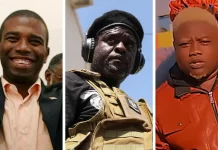


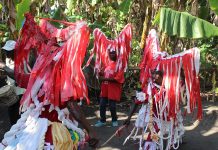

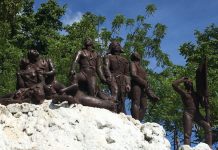



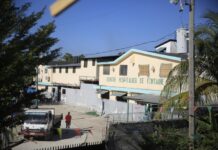
















![Phyllisia Ross – KONSA [Official Music Video]](https://haitiville.com/wp-content/uploads/2014/08/phyliisia.jpg)










